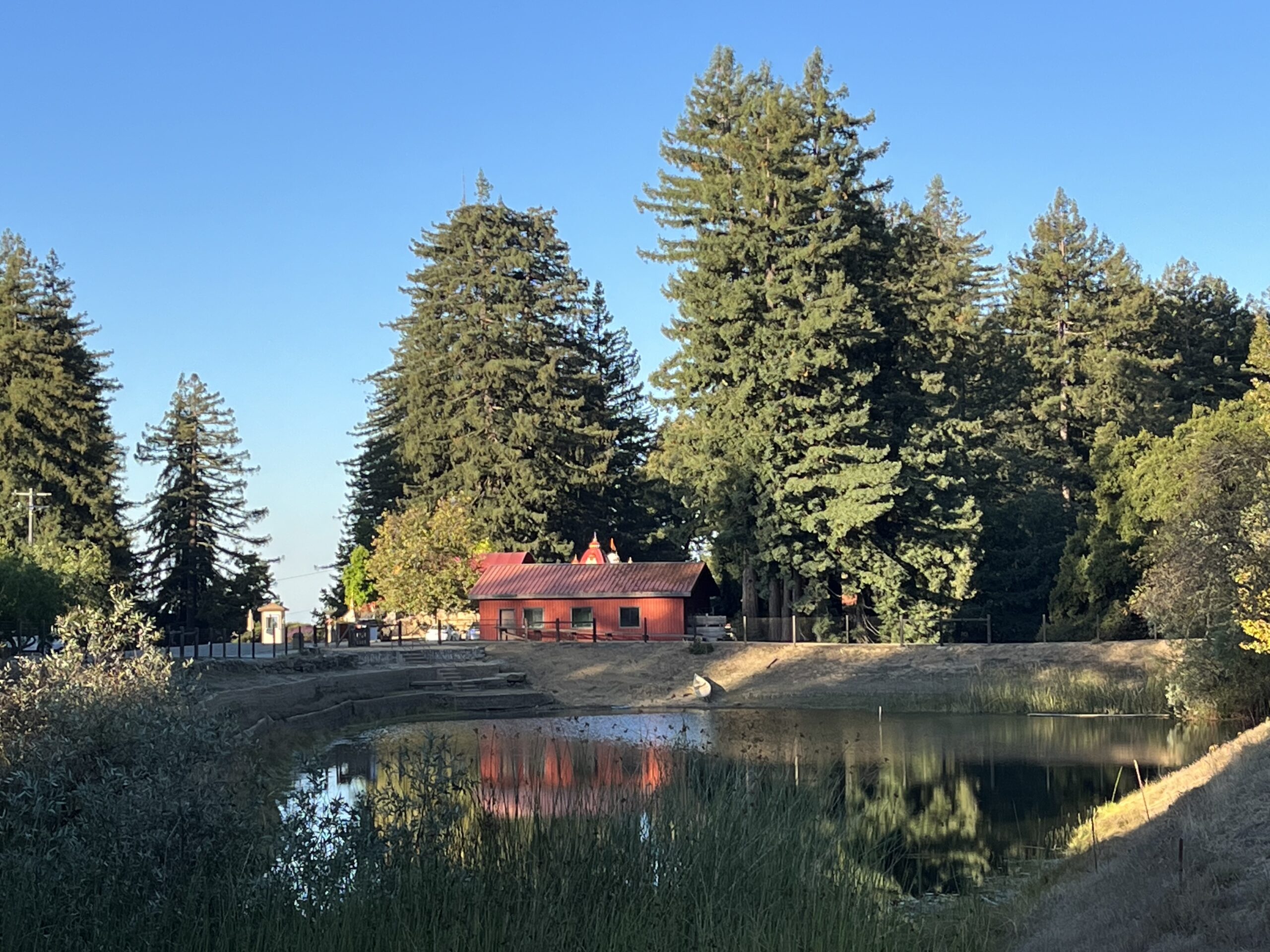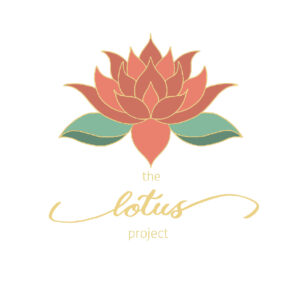 On a recent afternoon, wind-blown cumulus clouds filled the sky and sunlight permeated towering redwood trees and grassland meadows, reflecting off the water of a small lake on the Mount Madonna School (MMS) campus. As senior students navigated a short hillside trail from their classroom down to the lake, they chatted and took in an expansive view of Monterey Bay.
On a recent afternoon, wind-blown cumulus clouds filled the sky and sunlight permeated towering redwood trees and grassland meadows, reflecting off the water of a small lake on the Mount Madonna School (MMS) campus. As senior students navigated a short hillside trail from their classroom down to the lake, they chatted and took in an expansive view of Monterey Bay.
The students were accompanied by their teacher, Sara Sobkoviak, and guest Sukhdev Pettengill, a former Mount Madonna Center (MMC) resident, whom the students had invited to talk with them about the lake’s origins and water quality testing, in preparation for new water quality testing they will initiate. This field meeting is part of a year-long collaborative class effort ﹘ the Senior Capstone Project ﹘ with students committed to revitalizing and enhancing the lake ecosystem with native flora and fauna; developing an educational component to share with other students, lakeside signage; birdhouses and “forest mailboxes.”
“We chose this project mostly because we really like the lake,” said student Logan Shaw. “For most of us, it’s pretty nostalgic and we want to keep it preserved for future generations of students and the community to enjoy it, just as we have enjoyed it growing up.”
Student Beatrice Miller, the assistant project manager, asked Pettengill if there are water quality concerns as regards to wildlife – including the abundant deer and turkeys – drinking from the lake’s waters. While all warm blooded animals carry E. coli bacteria, Pettengill told them it isn’t a huge concern as the water isn’t potable. He suggested that any testing should include checking for bacteria, for informational purposes, as well as looking for nitrates, which are harmful to humans. Nitrate toxicity is a concern in communities where there is extensive chemical use or agricultural runoff, and gratefully, neither of these impact the Mount Madonna lake.
In previous years, MMS high school seniors have created and presented individual capstone projects. This year, Sobkoviak proposed the idea of a single collaborative group effort to be selected by the students. Students chose from several ideas submitted by school faculty, staff and the MMC community, and unanimously selected to work on helping to revitalize the lake ecosystem.
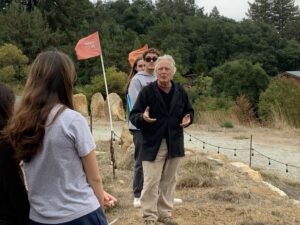 “The seniors’ efforts will be centered around helping to build the lake ecosystem so there is more abundance and diversity in wildlife and native plants,” said Sobkoviak. “They want to bring more of an intentional focus on nature to our own campus mountaintop, and have a more welcoming space for the community and visitors.”
“The seniors’ efforts will be centered around helping to build the lake ecosystem so there is more abundance and diversity in wildlife and native plants,” said Sobkoviak. “They want to bring more of an intentional focus on nature to our own campus mountaintop, and have a more welcoming space for the community and visitors.”
Once their project focus was selected, students self-organized by writing their own “job titles” and descriptions, making agreements and norms as a framework for each class, and even incorporated a project management tool, Notion, to help them stay informed on timelines, communications and project processes. They also drafted a mission statement, a list of objectives and identified the stakeholders who will be impacted by the project.
Students will partner with outside organizations such as Watsonville Wetlands Watch (which they will visit on November 13) to learn about the area’s native species, and receive advice on the steps to attracting more wildlife, in general, and birds, specifically. Their project scope includes reducing the populations of some of the non-native invasive species such as bullfrogs and the waterweed, elodea. The elodea, frequently used in home fish tanks and aquariums, may have originally been introduced to the lake by someone emptying a home set up years ago – along with non-native goldfish, which through the years have multiplied.
“I’m interested in the water safety aspects of the project and helping to clear the water of elodea,” said 12th grader Wyatt Adams. “At the least, we want to reduce the amount of elodea present, as it does affect the overall water quality. We’ve been swimming in the lake since preschool, and we want to help improve it so other people can enjoy it safely, like we have.”
Elodea removal got underway a few weeks ago, with an MMC resident operating an aquatic “harvester” on the lake, its mechanical “jaws” grabbing large swaths of the waterweed from open sections of the lake and piling it on the shore, to later be composed. Preschool through fifth grade students arriving at the lower school bus stop, lakeside, were fascinated with watching this activity! Next spring, the senior students themselves will hop in the water and complete a manual removal of additional elodea that is growing around a protected lotus garden at one end of the lake.
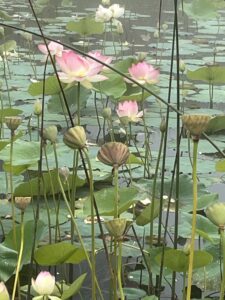 The students have dubbed their effort The Lotus Project, in recognition of a healthy grove of Nelumbo nucifera lotus, which are a distinct and visible feature along the lake’s northeast shore. Student Sophia Manzur is the project’s social media manager and Cy Harris is the lead designer. Harris designed a colorful lotus blossom logo to help brand the project, while Manzur curated a color palette based on the design to use for social media posts tied to the logo.
The students have dubbed their effort The Lotus Project, in recognition of a healthy grove of Nelumbo nucifera lotus, which are a distinct and visible feature along the lake’s northeast shore. Student Sophia Manzur is the project’s social media manager and Cy Harris is the lead designer. Harris designed a colorful lotus blossom logo to help brand the project, while Manzur curated a color palette based on the design to use for social media posts tied to the logo.
“It’s their vision from start to finish,” Sobkoviak commented. “Many students in this class have a long association with the school, campus and lake, and feel strongly about taking on this restoration effort. I also have a special interest in regenerative agriculture and this opportunity to reestablish native plants and animals into this campus lake ecosystem is especially meaningful. My own role with this will be very much as an advisor – the effort and work will be student-led and student-driven.”
The lotus are in full bloom during the late summer and early fall, drawing the eye of students, visitors and the broader community. The original lotus were introduced into the lake 10 to 15 years ago by MMC community member Sudhir Dass, who added seeds and tubers donated from a local gardener’s pond. The species is not invasive and there are no plans to remove it from the lake waters.
 “As a photographer I was attracted to the lotus flowers,” said Dass. “I have visited ponds around the world and taken photographs of them and water lilies. They of course have spiritual significance, particularly in the Buddhist cultures. Poets, artists and photographers are drawn to their beauty and symbolism.”
“As a photographer I was attracted to the lotus flowers,” said Dass. “I have visited ponds around the world and taken photographs of them and water lilies. They of course have spiritual significance, particularly in the Buddhist cultures. Poets, artists and photographers are drawn to their beauty and symbolism.”
A couple years ago, Dass asked a friend to paint the mantra, “Om Mani Padme Hum” in Sanskrit on a series of large “sentinel stones” that overlook the lake. Known as the Compassion Mantra, or the Jewel in the Lotus, this Buddhist prayer is employed as a tool to train the mind to achieve ultimate peace and enjoyment.
At capacity, the lake can hold some five and half to six acre feet – roughly one and a half million to two million gallons – of water. It is sited on a 380-acre property shared by the school, MMC residents and guests, and the Mount Madonna Institute, a classical yoga school and Ayurvedic college.
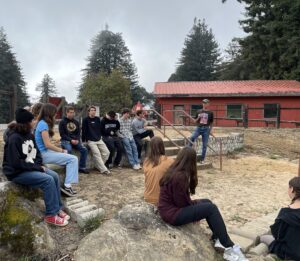 “The lake has been a beautiful part of my childhood since I came to MMS in kindergarten,” said student Anya Gonzalez, fondly recalling time spent at and around the lake, including morning hikes with her classmates and teachers. Gonzalez serves as the project’s marketing and communications coordinator.
“The lake has been a beautiful part of my childhood since I came to MMS in kindergarten,” said student Anya Gonzalez, fondly recalling time spent at and around the lake, including morning hikes with her classmates and teachers. Gonzalez serves as the project’s marketing and communications coordinator.
Early in the fall, student project manager Isaiah Orozco reached out to Dayanand Diffenbaugh, a founding member and resident of MMC, to ask if he would meet with the class, share history and tell them about the land before the lake was created. Following a fire that occurred on the property in 1984, Diffenbaugh helped to construct the lake to provide both an agricultural water supply for gardens and orchards on the property, as well as a water reservoir and pipeline infrastructure required by the fire marshal.
“We learned from Dayanand about variations in the life of the lake,” said Sobkoviak, “and other aspects like drainage, filtration and even the species that can be found there.”
Several students expressed support for the creation of “forest mailboxes” to connect younger and older students, and the school and center communities.
“We want to nurture the connections with our younger buddies and among the school community,” commented Gonzalez. “When I was in first grade, I was paired with Lexi Julien (’15). Recently, I came across a note she had written to me years ago and reread it; our buddy relationship meant a lot. As part of our project, we want to design, build and install forest mailboxes to leave things such as notes and jokes for our little buddies, or to receive advice and or pictures from our MMC friends.
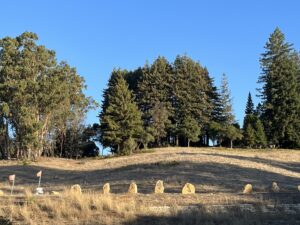 “During our time as students, I have noticed a real separation of the school and center,” she continued. “The center is such a big part of our school’s origins and why we’re here, and yet we don’t often come in contact with the center community except during ‘Ramayana!’ Through this project, we hope to rebuild the connection with MMC, and strengthen our broader personal and organizational relationship.”
“During our time as students, I have noticed a real separation of the school and center,” she continued. “The center is such a big part of our school’s origins and why we’re here, and yet we don’t often come in contact with the center community except during ‘Ramayana!’ Through this project, we hope to rebuild the connection with MMC, and strengthen our broader personal and organizational relationship.”
“It’s really positive that the students identified this as a project they would like to invest their own energy into,” said Diffenbaugh.” Students love the lake, they have memories of it, they played here. I love that they understood intuitively that such identity with the land is important, and in indigenous cultures, it’s essential.”
“The landforms, plants and animals we grow up with imprint on each of us,” he continued. “We carry these ‘landscape memories’ forward and they become part of our identity. I like that the 12th grade students, on their own, have a sense of identity with Mount Madonna. This is something that we, as a community and a school, are giving to our students and community members, and it becomes associated with their ideas on justice, stewardship and sustainability. It helps to grow, in a practical sense, an understanding of the value of nature and the responsibility and need to preserve it.”
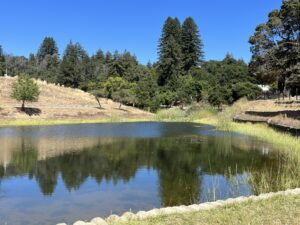 Students Cooper Padilla and Ethan Lee are teaming up to research the existing plants and animal species that are part of the ecosystem.
Students Cooper Padilla and Ethan Lee are teaming up to research the existing plants and animal species that are part of the ecosystem.
“We are looking at possibly creating and installing illustrated boards or signage to educate students and visitors about the lake ecosystem,” said Padilla.
“It’s important to me that we don’t just go in uninformed and change habitat,” said Lee, “without the benefit of conducting an ethogram study, and preserving what’s there.”
Students Bella Sol Padilla and Irulan Cockrum are working on the conceptual design process for the physical campus “beautification” pieces – such as windchimes created from found and natural objects, the design of birdhouses and forest mailboxes. Seniors Erin Kavitsky and Peter S. are responsible for engineering and building the designs developed by their classmates. The students hope to add several birdhouses to the lakeside environment once they’ve consulted with experts to learn about what type of birds would be beneficial to attract.
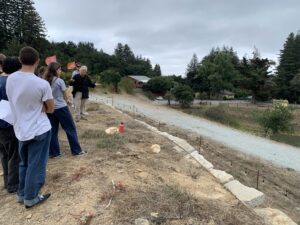 “When I was younger, I used to look around and see photos of students with math and science teacher PD Rohan and the different projects they were doing around the lake and the campus,” explained Cockrum. “Thinking about this, I realized I want that to be me, too; I want to leave a lasting, positive impact on this place…on these mountains. My class wants to be part of the school’s legacy through our work on this project.”
“When I was younger, I used to look around and see photos of students with math and science teacher PD Rohan and the different projects they were doing around the lake and the campus,” explained Cockrum. “Thinking about this, I realized I want that to be me, too; I want to leave a lasting, positive impact on this place…on these mountains. My class wants to be part of the school’s legacy through our work on this project.”
Emma Monclus and Ona Musoll-Buendia, meanwhile, are partnering to develop an educational curriculum for younger children.
“My mother is a teacher, and awhile back we went to a lake together and caught these small frogs to show to the little kids,” explained Monclus. “They were so excited and curious; and I want to bring that kind of excitement here to our little buddies and the children of MMS.”
As the group headed back to their classroom to continue working, Orozco asked Pettengill, “So, what do you think of our project?”
“As envisioned, I think it’s a really good project,” said Pettengill. “It will enhance the overall environment and bring in more wildlife through building birdhouses and improving habitat to increase the diversity of wildlife – and this work will benefit both the immediate and broader ecosystem.”

